No-bake snow skin mooncakes are a simple, tasty alternative to traditional mooncakes. They consist of a tender, slightly chewy skin and a creamy custard filling. Follow my detailed instructions to make some!
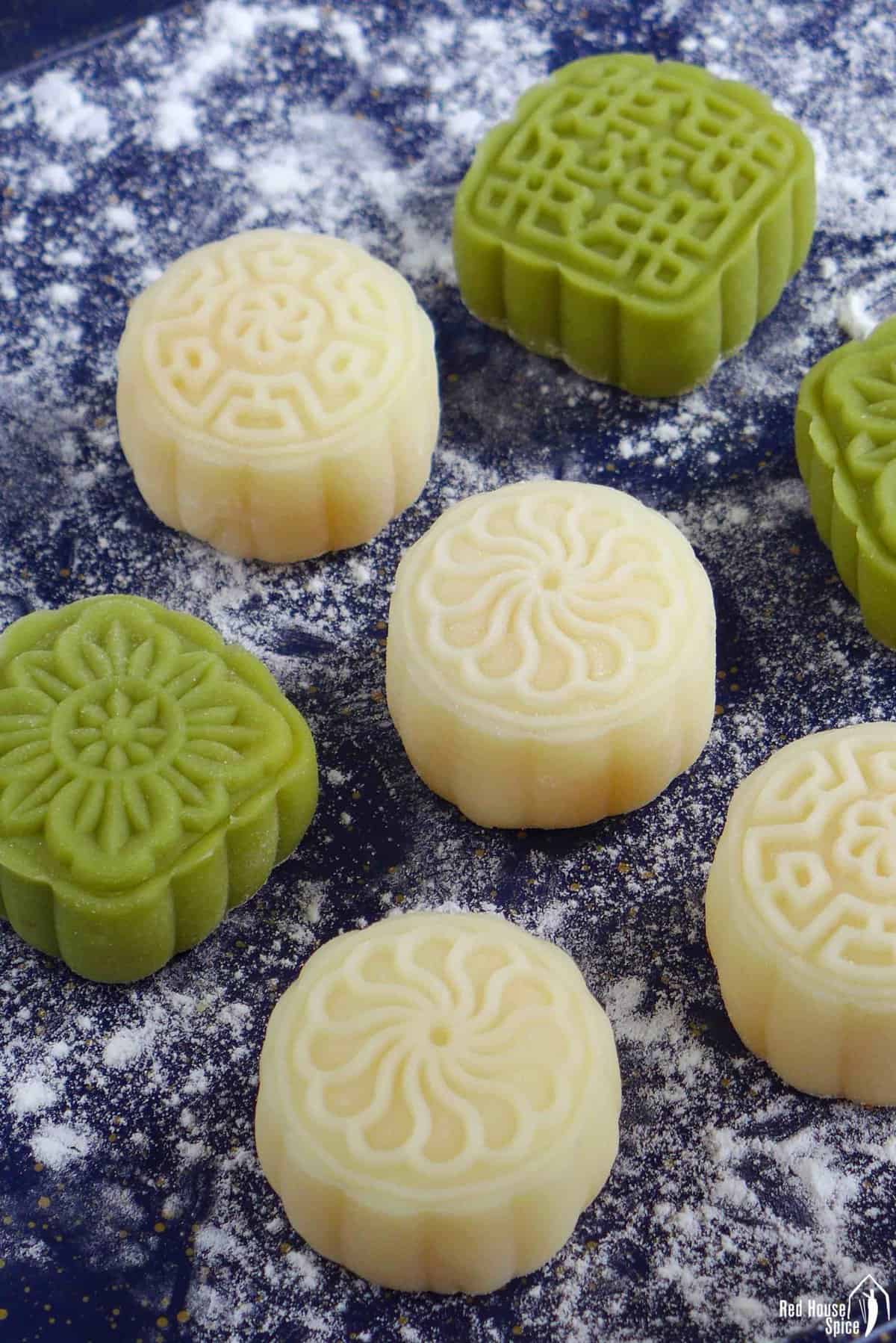
Update Notice: This is a revised version of my original post published in 2017. It includes alternative cooking methods, more tips and a video.
According to the Chinese lunar calendar, Mid-Autumn Festival (Zhōng Qiū Jié/中秋节) is on the 15th day of the 8th month of the year which is a full moon day (It falls on Saturday, the 10th of September in 2022). Apart from the tradition of moon gazing, eating mooncakes is an absolute must for Chinese around the world.
As its name suggests, mooncake (Yuè Bǐng, 月饼) is a cake that resembles the shape of the moon. Comprising a crust and a filling, they are made with different tastes and appearances using various methods across China.
Every year, I make two types to celebrate this special occasion. One is the traditional Cantonese mooncakes with salted egg yolk. The other is the modern snow skin mooncakes which are much simpler to make.
What is snow skin mooncake
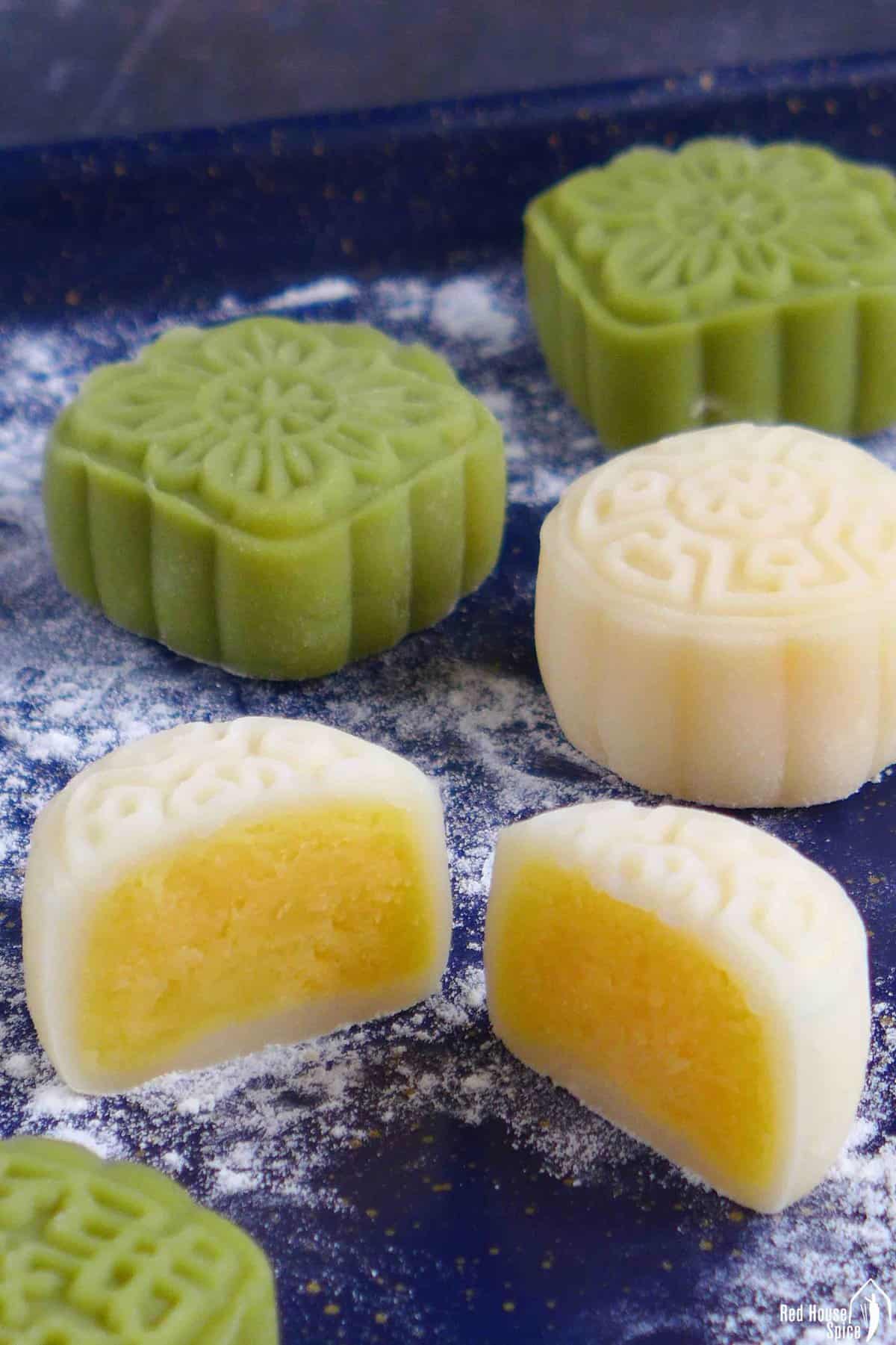
Known as Bīng Pí Yuè Bǐng/冰皮 in Chinese, snow skin mooncake is believed to have originated in Hong Kong (although some argue that it’s from Singapore). It has become increasingly popular in Chinese bakeries, as well as in family kitchens, thanks to its diverse appearance and simple cooking procedure.
The original version of snow skin mooncake has a white, chewy, mochi-like outer layer and is served cold. That’s how it got the name “snow skin”. Nowadays, you can find colorful ones which are even more attractive.
They can be stuffed with regular mooncake fillings, such as red bean paste, lotus paste, black sesame paste, etc. The custard filling that I’m introducing today is the most popular type I’d say.
Key features
Compared to traditional mooncakes, here are a few features of snow skin mooncakes:
- No baking is involved
- They’re less tricky to make thus novice-friendly
- They can be easily colored with natural ingredients
- You can improvise with the filling, e.g. try ice cream!
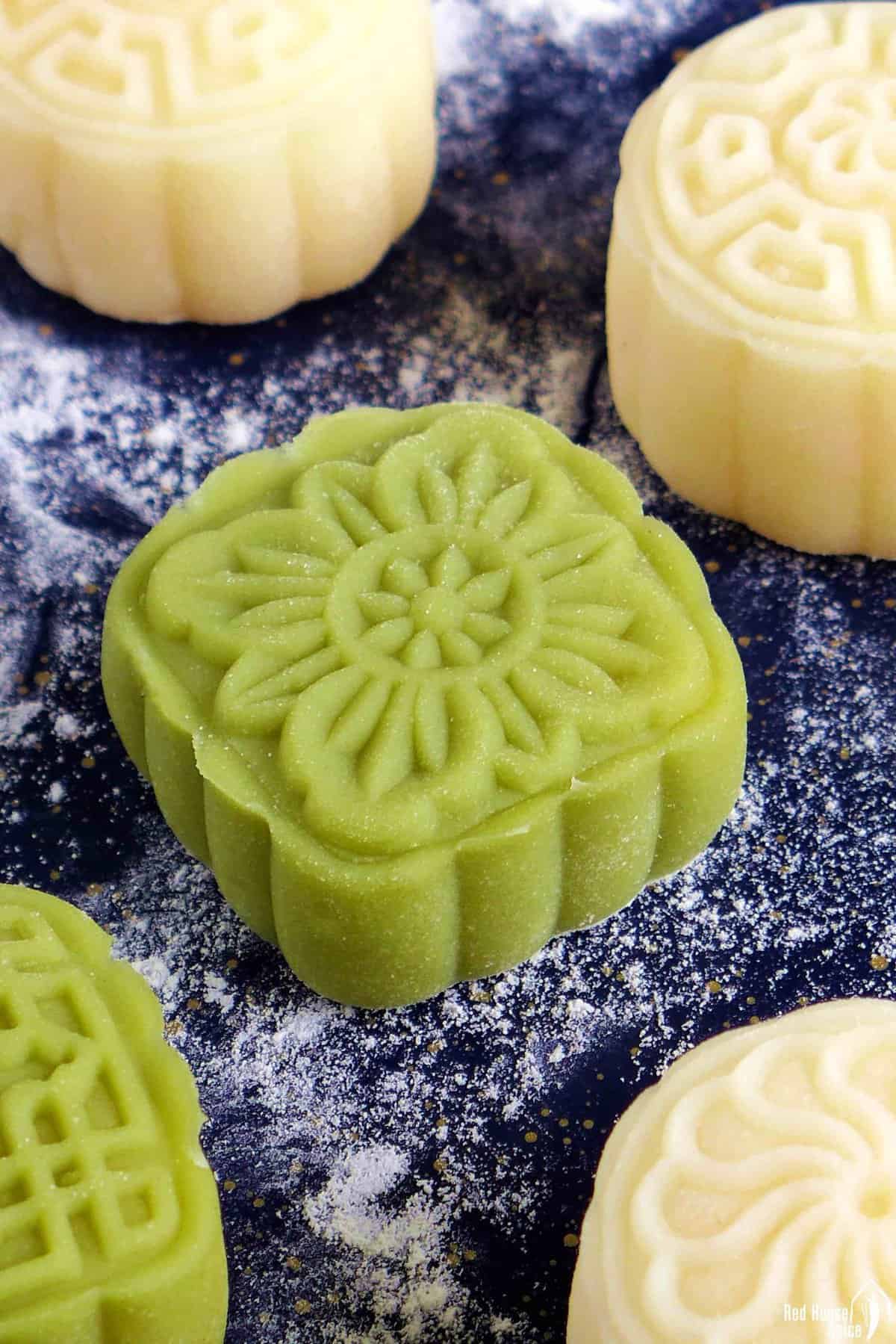
Recipe summary
Before I discuss more detailed instructions and tips, here is a summary of how to make snow skin mooncake with custard filling:
- Heat all the ingredients for the filling in a pan until they turn into a paste. Refrigerate to firm up.
- Mix all the ingredients for the skin into a batter. Steam (or microwave) to harden. Then knead briefly into a dough.
- Divide the dough and the filling into equal pieces. Wrap the filling with the dough to form a ball. Use a mooncake mold to shape. Then you’re ready to serve!
Equipment required
Apart from regular kitchen tools like pans, bowls, plates, spatula, etc, you’ll need the following:
Mooncake molds
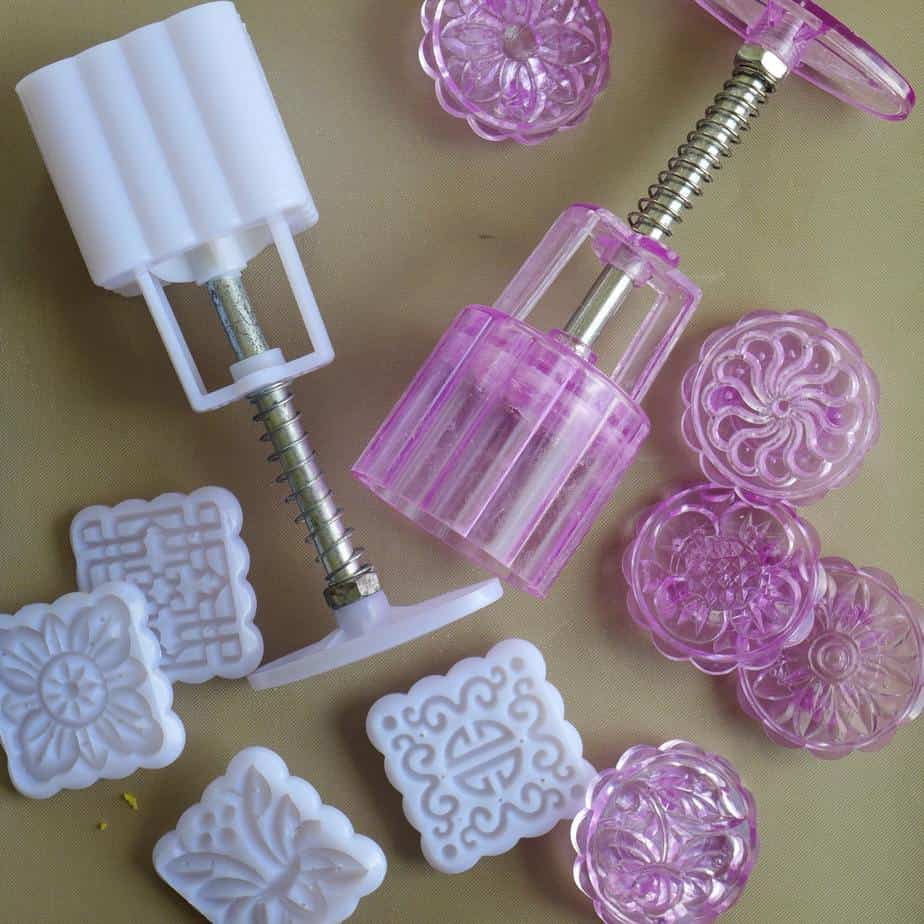
I prefer the modern plastic mooncake molds which have springy handles. They’re easy and neat to use. Also, each mold comes with several plates with different patterns. The traditional wooden ones would work too if you already have one.
You can find mooncake molds in some Chinese stores, especially around Mid-Autumn Festival time. They’re also available on major online shopping platforms, such as Amazon, eBay, etc.
Kitchen gloves
The mooncake skin tends to stick to your hands. So a pair of food-grade gloves would help a lot.
Make the custard filling
Custard filling (奶黄馅) is very popular in Chinese sweet treats (think dim sum style Steamed Custard Buns). Its creamy, soft texture pairs perfectly with this type of mooncake skin.
Ingredients for the filling
Here are what you’ll need to make custard filling:
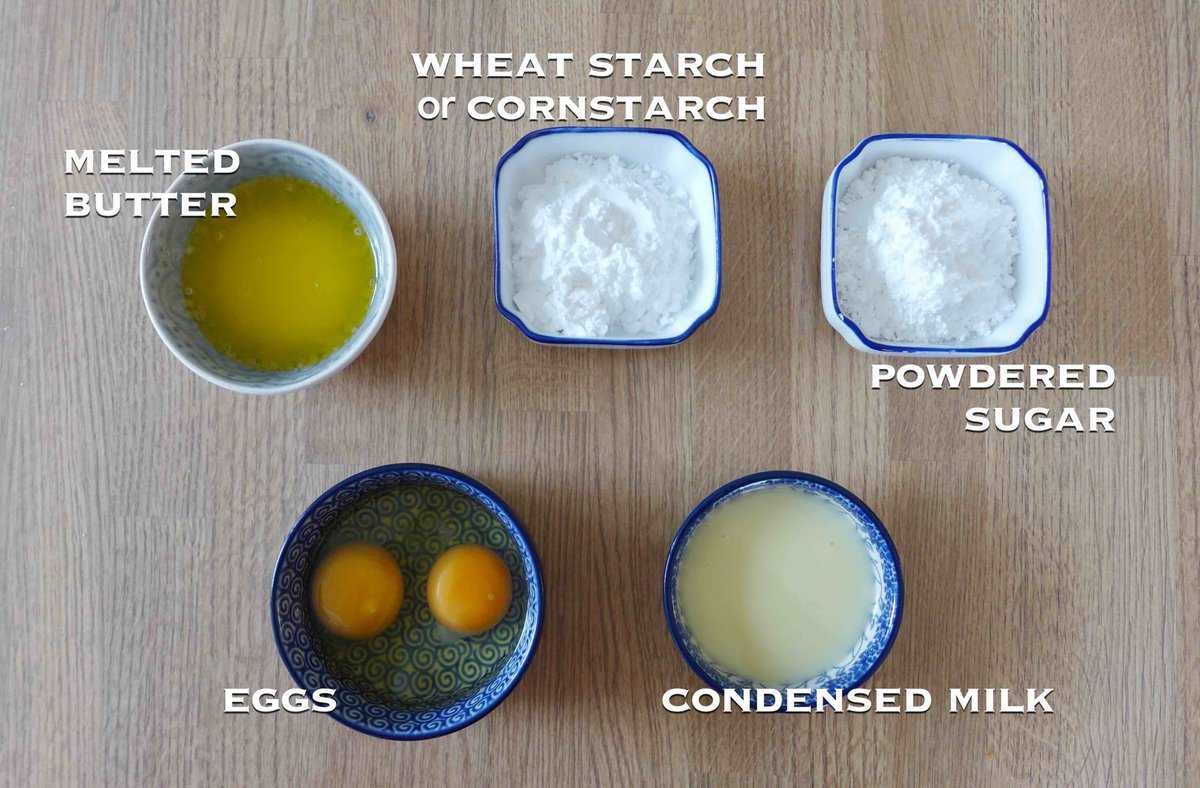
- Wheat starch, or cornstarch/tapioca starch
- Powdered sugar (aka icing sugar)
- Condensed milk (or milk powder)
- Unsalted butter, melted
- Eggs
Cooking steps
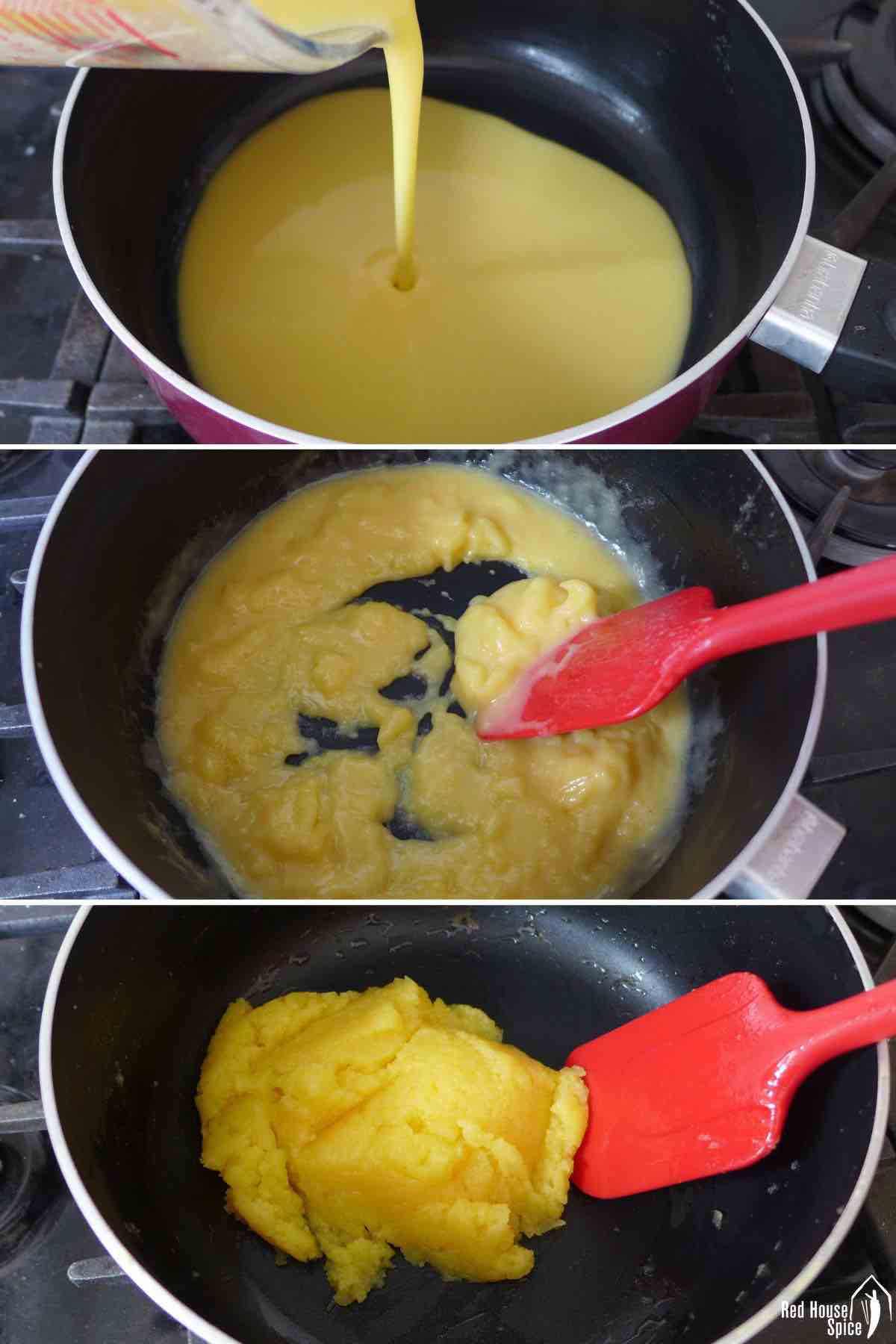
- Mix all the ingredients above until they’re fully incorporated. Pour the mixture into a saucepan.
- Cook it over low heat. The mixture will start solidifying at the bottom of the pan. Keep stirring and folding with a flexible spatula to avoid burning.
- Once it turns into a solid mass, transfer it to a bowl. Put cling film tightly over the cooked filling. Once completely cool, refrigerate it for 2 hours to firm up further.
🛎 Pro tips:
- Remember to keep the heat very low. Do not boil. Otherwise, the filling will become lumpy.
- Do not overcook. The filling should hold in shape but not too dry (It’ll become harder once chilled). For the desired consistency, please refer to the video in the recipe card below.
Other filling options
Many common sweet fillings for Chinese treats can go into snow skin mooncakes. I’ve written a post on how to make red bean paste. Also, you can find instructions on homemade lotus seed paste in my recipe for Cantonese Mooncake with Salted Egg Yolk, and black sesame paste (黑芝麻馅) commonly used in Glutinous Rice Balls.
Prepare the skin
The outer part of snow skin mooncakes has a chewy, sticky and springy mouthfeel which I find very pleasant. It’s similar to the texture of mochi but a bit firmer, as it needs to be pressed to a particular shape and pattern.
Ingredients for the skin
You’ll need the following to make the dough:
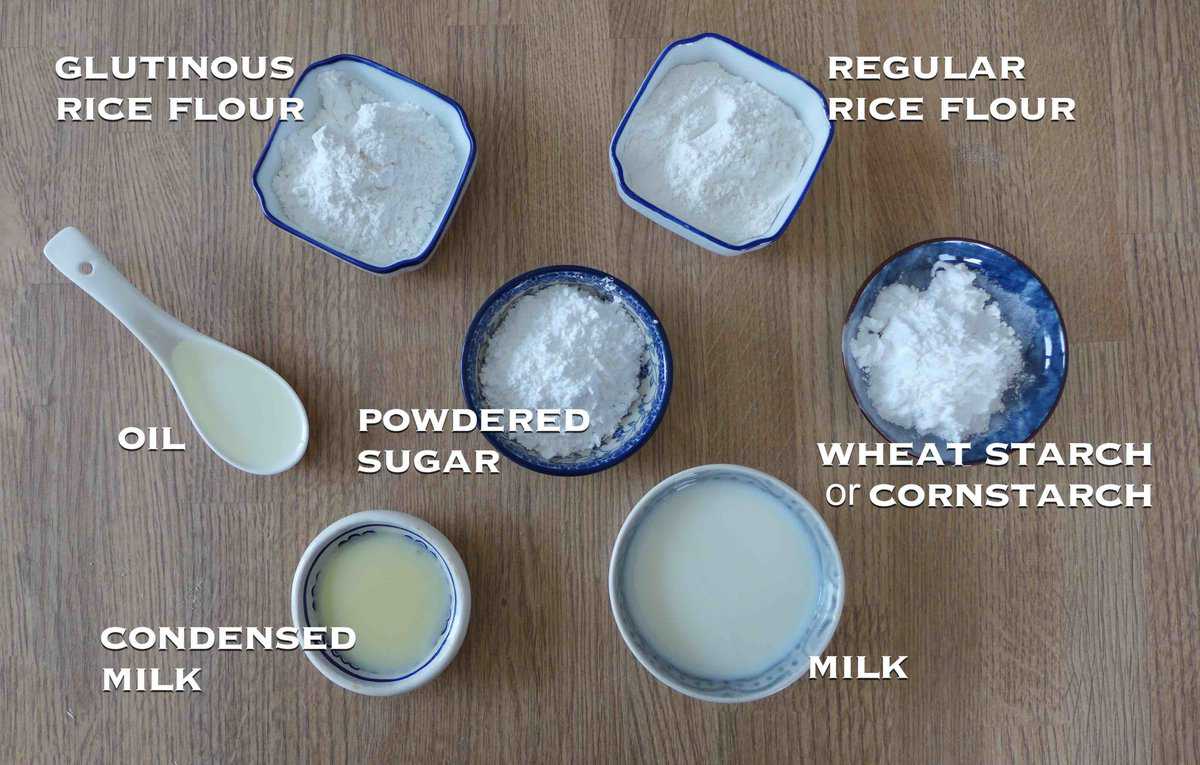
- Glutinous rice flour (糯米粉)
- Regular rice flour (粘米粉)
- Wheat starch (澄粉), or cornstarch/tapioca starch
- Powdered sugar (aka icing sugar )
- Milk (full-fat or semi-skimmed)
- Condensed milk
- Neutral cooking oil (e.g. canola, vegetable, rapeseed, sunflower, etc.)
A trip to a Chinese store would be necessary to purchase glutinous rice flour, regular rice flour and wheat starch. Condensed milk adds a rich flavor to the skin and it’s widely available in mainstream supermarkets.
🛎 Pro tips:
- Don’t omit regular rice flour: Some recipes suggest that you use only glutinous rice flour. I don’t suggest you skip regular rice flour. As I explained in my post on Sichuan Leaf-wrapped Rice Cakes, it helps the dough to stay in shape and to avoid it being overly sticky.
- For a gluten-free diet: use cornstarch or tapioca starch instead of wheat starch which usually contains a very small amount of gluten (Unless your wheat starch is clearly labeled as gluten-free). They produce almost an identical result.
Cooking steps

1. In a mixing bowl, whisk all the ingredients for the skin until well combined. Pour the mixture into a deep plate.
2. To cook it, you have two options. Both work well. After cooking, the batter should turn completely solid (The time required may vary a little depending on your device. Adjust if necessary).
- OPTION 1: Microwave – Cover with a plate to avoid splashing. Cook on high power for 4 minutes.
- OPTION 2: Steam – Cover with a plate to avoid dripping water. Steam over medium-high heat for 20 mins.
3. With a flexible spatula, scrape the hardened dough off the plate. Transfer it to another plate to cool quickly.
4. Once no longer hot to touch, combine and knead it with gloved hands until it becomes smooth and elastic.
🛎 Pro tips:
- Knead the dough very well. This helps to reduce stickiness.
- Cover the kneaded dough tightly with cling film. To make assembly easier, chill it in the fridge for 1 hour.
- If you double the quantity of the recipe, microwave the mixture in two batches. If steaming, increase the time to 30 minutes.
Shape the mooncakes
Before assembly, make sure the dough and the filling have been chilled so they are reasonably firm to touch. This way, they are much easier to handle.
To prevent the mooncakes from sticking to the mold, you also need a little dusting flour. You can make it by toasting some glutinous rice flour over low heat for about 4 minutes. Leave to cool for later use.
To assemble the mooncakes, follow these steps:
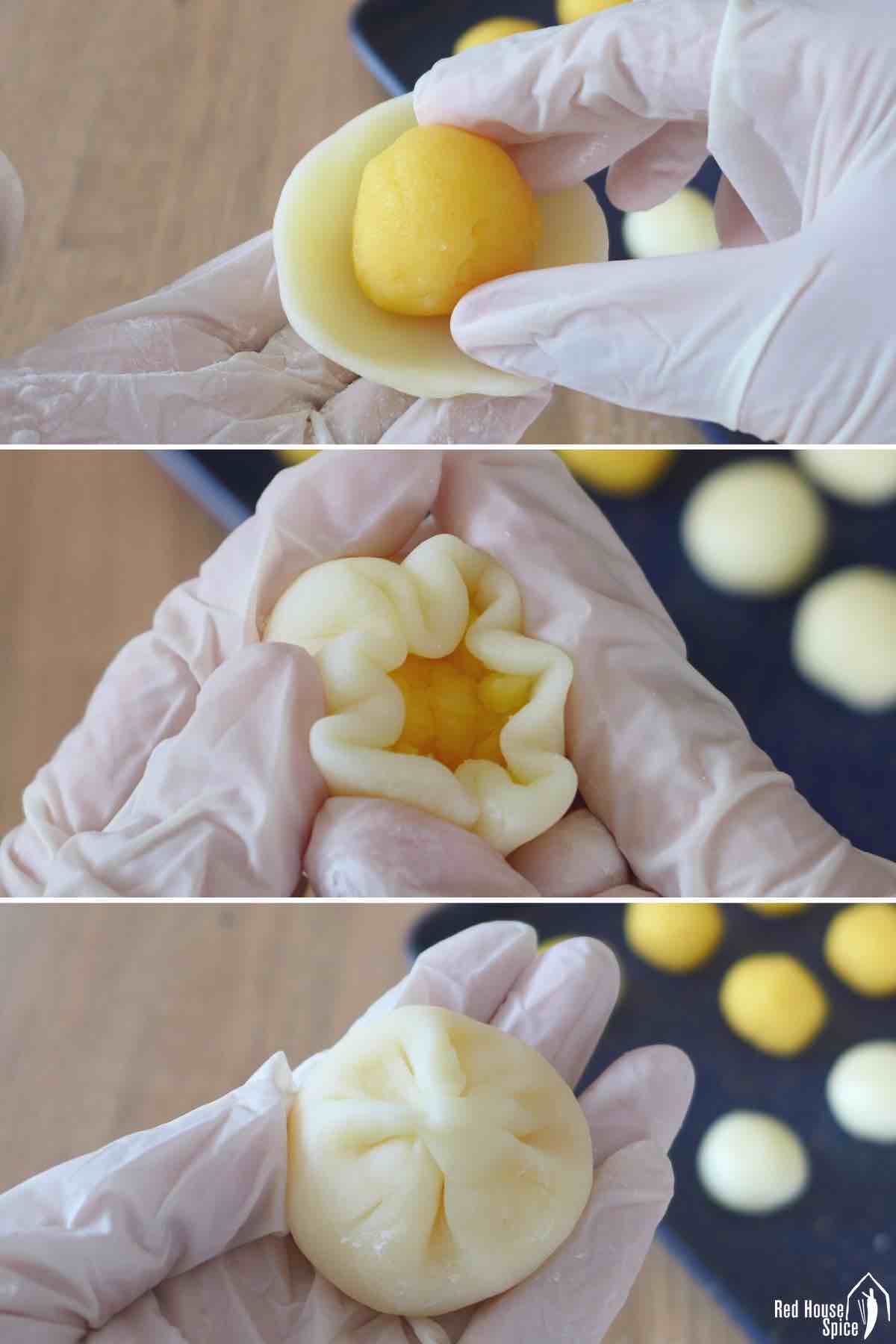
1. Divide the dough and filling into equal pieces (a kitchen scale helps). Roll each into a ball.
2. Flatten a piece of dough into a disc. Place a piece of filling in the middle.
3. Gently push the wrapper upwards to tightly cover the entire filling. Seal well on the top.
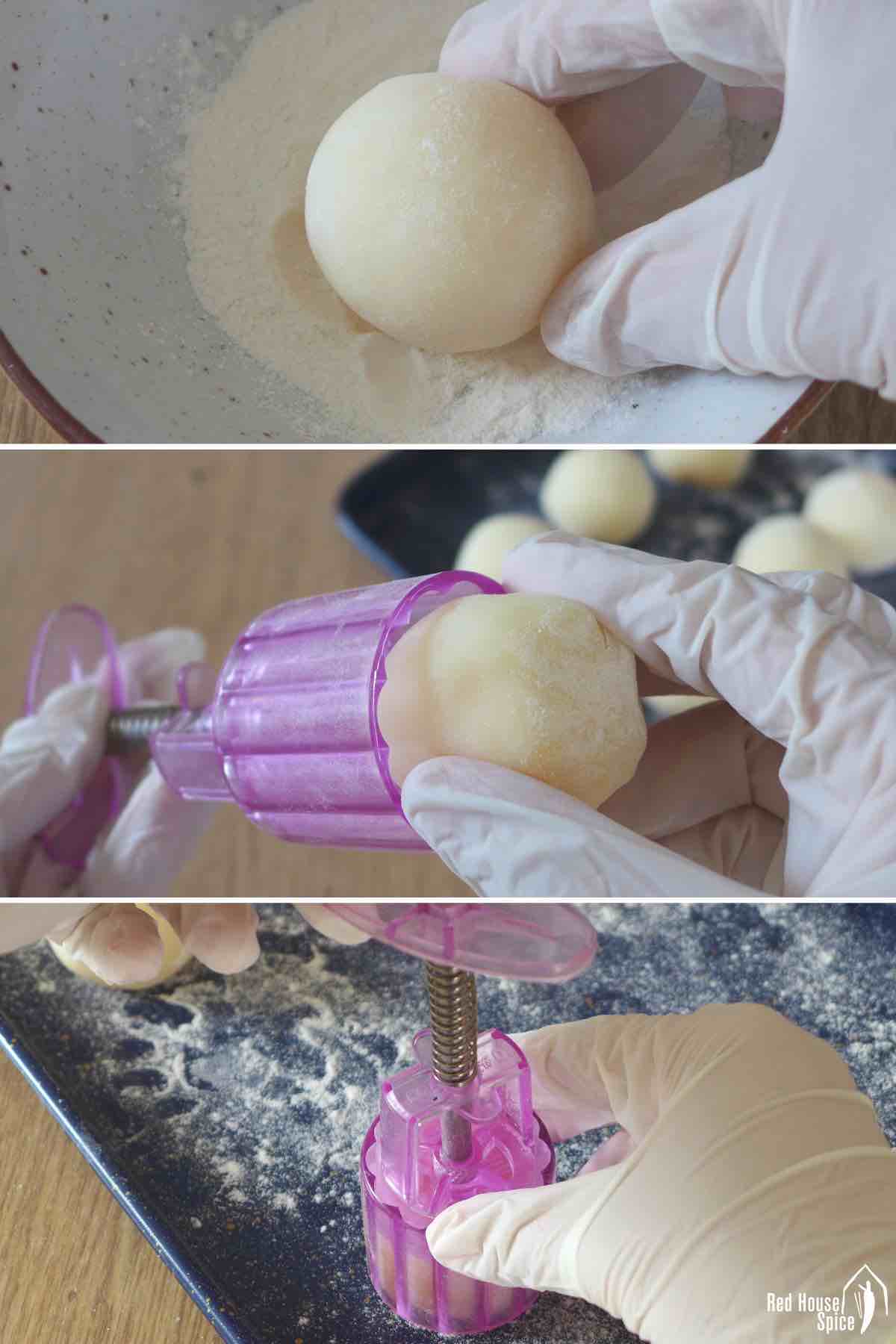
4. Roll the assembled ball in the toasted glutinous rice flour to gain a thin coating.
5. Put it into a mooncake mold. Place the mold on a flat, lightly dusted surface. Press the springy handle to shape the mooncake.
6. Lift the mold up. Press the handle again to push the mooncake onto the surface.
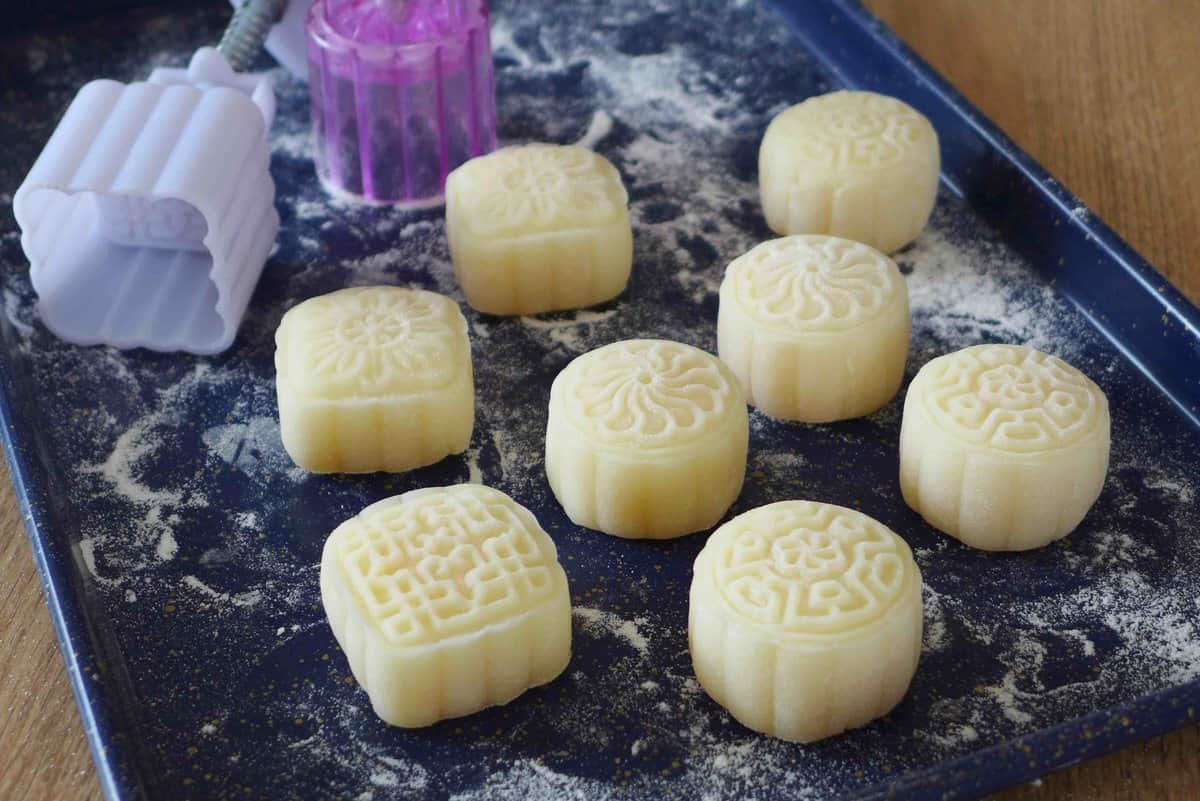
🛎 Pro tips:
- Remember to wear gloves to avoid sticking.
- If your mooncakes don’t come off the mold easily, lightly dust the mold beforehand.
- If using a traditional mold, dust it well then put the ball in. Press to flatten. Tilt the mold while tapping it gently until the mooncake falls off.
Make them colorful
When possible, I like coloring my food with natural ingredients (I did so in my recipe for Colorful Dumplings, Mango Pancakes, and Glutinous Rice Balls). If you wish to make your mooncakes colorful, follow these tips:
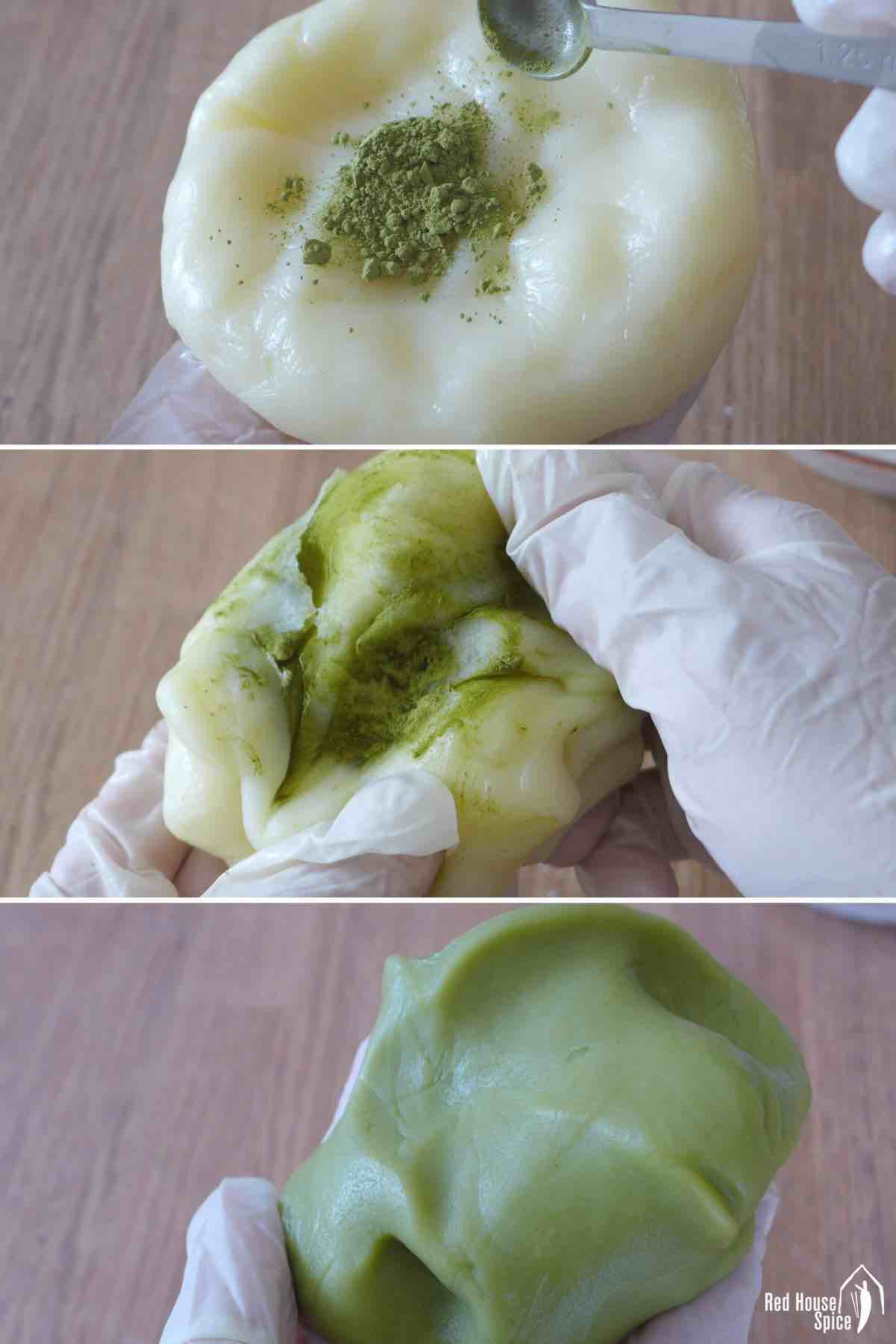
- Natural ingredients work well, such as matcha powder or spinach powder for green; purple sweet potato powder for purple; beetroot juice for pink, etc.
- Simply sprinkle the powder or juice over the cooked dough, then knead well to distribute the color until it becomes even.
- Add the coloring powder/juice little by little until the desired color shade appears.
- You can also mix two or three different pieces of dough to create a marble effect.
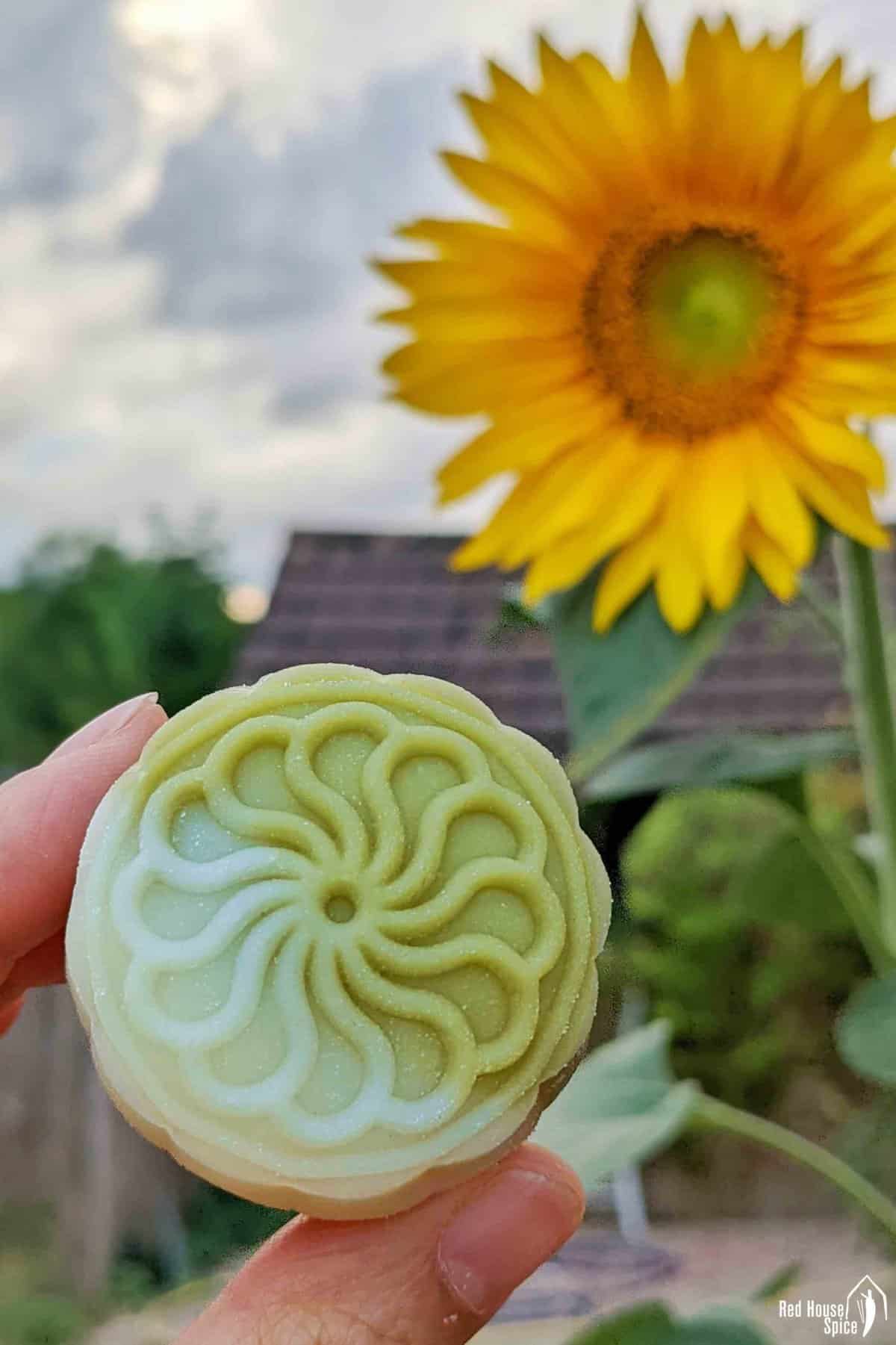
Serve & store
Right after assembling, your mooncakes are ready to be served! Enjoy them as an afternoon snack or a dinner treat.
If you plan to eat them later, here is how you store them:
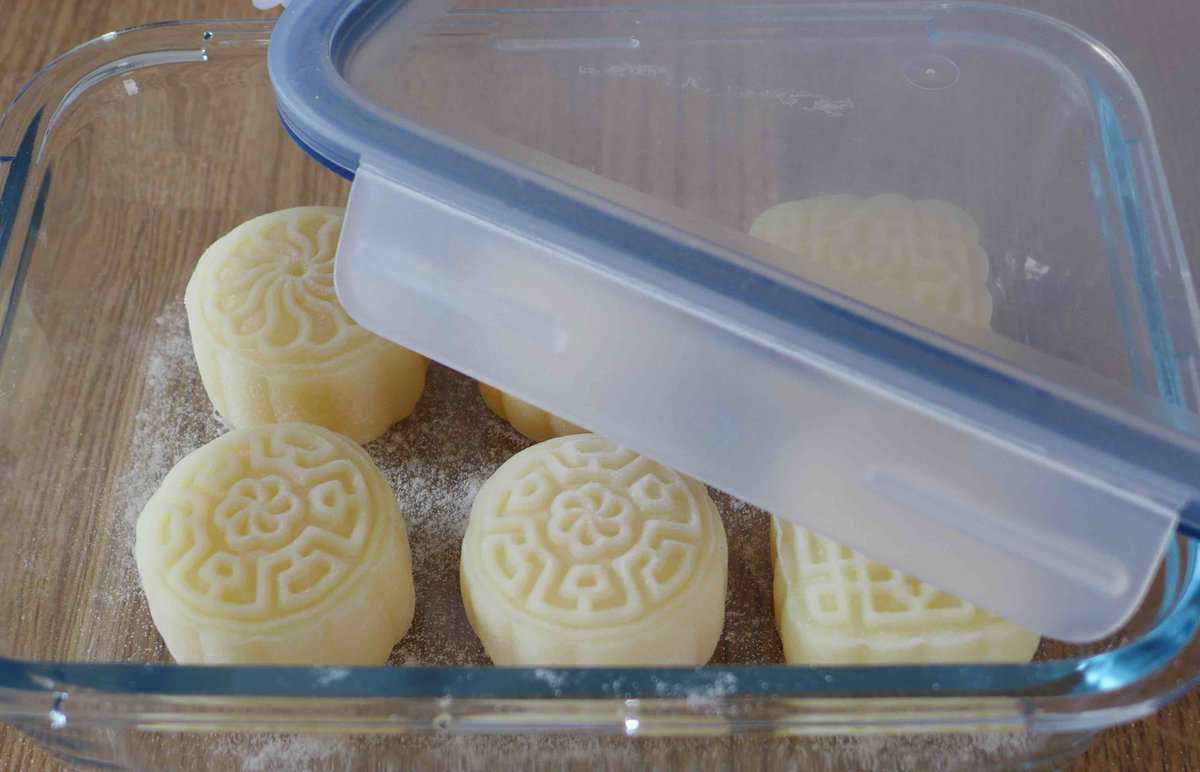
- In the fridge: Place them in air-tight containers and consume within 72 hours. Make sure you add a layer of parchment paper between each layer if you have to stack them up.
- In the freezer: Freeze them as soon as they’re assembled in air-tight containers/plastic bags for up to 1 month. Leave to thaw in the fridge.
How to rescue hardened mooncakes?
The outer layer of snow skin mooncakes tends to harden over time. If they’re made just a day ago, simply bring them back to room temperature.
If they’ve been stored for longer, use one of the following methods to soften them up:
- Microwave method: Wet them with a very thin layer of water then put in a microwave-safe plate/bowl. Cover with cling film or a plate. Microwave on high power for 15 seconds. Check the softness and cook 10 more seconds at a time until they have your preferred softness. You may need to flip the mooncakes once if you find one side stays hard.
- Steamer method: Steam the mooncakes for 2 minutes. Check the softness. Cook a little longer if needed. They’ll become quite sticky on the surface right after steaming. Leave to cool for a while then serve.
Recipe FAQs
A: No, it won’t work for this recipe.
A: If you have a multi-layer steamer, you can add the batter into several plates and steam just once. This way it will be cooked through. Otherwise, cook it in bigger plates in several batches and extend the time if necessary (The idea is to spread out the batter as shallow as possible).
A: It’s perfectly normal to see that. But make sure you keep the oil and knead it into the dough. This will keep the skin stay tender for longer.
A: If you’ve used the ingredients and ratio suggested in the recipe, highly likely this is because the batter hasn’t been cooked through. Every microwave (or cooker if steaming) performs differently. Slightly extend the time in your case.
A: It will work. Make sure you use hard serve ice cream which takes longer to melt (avoid slow churned ice cream or sorbet). Also, act fast when assembling.
Other festive treats
Fancy more Chinese sweet treats? Check these recipes:
📋 Recipe
Love this recipe? Please leave a 5-star 🌟🌟🌟🌟🌟 rating in the recipe card below & if you REALLY like it, consider leaving a comment as well!
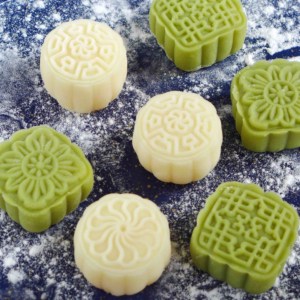
Snow skin mooncake with custard filling (冰皮月饼)
BEFORE YOU START
EQUIPMENT
- Mooncake molds for making small 1.8oz/50g ones
- Food-safe gloves
Ingredients
For the filling
- 2½ tablespoon wheat starch - or cornstarch/tapioca starch (see note 1)
- 3 tablespoon powdered sugar - aka icing sugar
- 3 tablespoon unsalted butter - melted
- 2 tablespoon condensed milk - See note 2 for substitute
- 2 large eggs
For the skin
- 3 tablespoon glutinous rice flour
- 3 tablespoon regular rice flour
- 2 tablespoon wheat starch - or cornstarch/tapioca starch
- 3 tablespoon powdered sugar - aka icing sugar
- ½ cup milk
- 1 tablespoon condensed milk
- 1 tablespoon neutral cooking oil
- Matcha powder - for coloring (optional)
For dusting
- 2 tablespoon glutinous rice flour
Instructions
Make the filling
- Mix wheat starch (or cornstarch/tapioca starch), powdered sugar, melted butter and condensed milk until well combined. Add the eggs. Lightly beat until fully incorporated.
- Pour the mixture into a saucepan. Cook over low heat. Once the mixture starts to solidify at the bottom of the pan, stir and fold constantly with a flexible spatula.
- When the mixture becomes evenly solid, transfer it to a bowl. It should hold in shape but not too dry (please refer to the video below for the desired consistency).
- Lay a piece of cling film tightly over the cooked filling. Leave to cool completely then put into the fridge to firm up further.
Prepare the skin
- While waiting for the filling to cool, prepare the skin. Put glutinous rice flour, regular rice flour, wheat starch (or cornstarch/tapioca starch) and powdered sugar into a bowl. Pour in milk. Mix until smooth. Add condensed milk and oil. Stir to combine.
- Pour the mixture into a deep plate, then cover it with another plate. Cook it using one of these methods: [Option 1] In a microwave for 4 minutes on high power; [Option 2] In a steamer for 20 minutes over medium-high heat (see note 3).
- By then the mixture should have turned solid. Use a flexible spatula to scrape it off and transfer to another plate to speed up cooling (see note 4).
- When it’s cool enough to touch, combine and knead it in your hands until it becomes smooth (you’ll need to wear food-safe gloves to prevent sticking). Wrap it with cling film if not used immediately.
Color the skin (optional)
- Sprinkle matcha powder or purple sweet potato powder over the cooked dough. Knead to distribute the powder until the color becomes even. For the entire dough this recipe makes, you’d need about ½ teaspoon of powder.
Toast the dusting flour
- In a pan, toast glutinous rice flour over low heat for about 4 minutes. Transfer out to cool for later use.
Shape the mooncakes
- Take the filling out and knead in your hands briefly to make it smoother. Divide it into 8 equal pieces and roll each into a ball.
- Also, shape the skin into 8 equal balls. Flatten one piece into a round wrapper. Place a filling ball in the middle. Gently push the wrapper upwards to tightly cover the filling. Seal at the top.
- Roll the assembled ball in the toasted glutinous rice flour. Rub off any excess flour leaving just a very thin layer.
- Put the ball into a mooncake mold. Place the mold, with the opening facing down, onto a lightly dusted surface. Press the springy handle then lift up the mold. Push the handle again to release the mooncake (see note 5).
Store
- In the fridge: Store them in air-tight containers in the fridge and consume within 72 hours.
- In the freezer: Lay them in a single layer to freeze. Once completely frozen, transfer them into air-tight containers/bags. Store in the freezer for up to 1 month.
Serve
- They’re best when consumed right after assembly. The skin will harden over time.
- To soften, you can [Option 1]: Lightly wet them and microwave them in a plate/bowl covered with cling film. Run on high power for 15 seconds. Check the softness and cook longer (10 seconds at a time) until softened. [Option 2]: Steam them for 2 minutes. Check the softness. Cook a little longer as needed.
Video
NOTES
NUTRITION
NUTRITION DISCLOSURE: Nutritional information on this website is provided as a courtesy to readers. It should be considered estimates. Please use your own brand nutritional values or your preferred nutrition calculator to double check against our estimates.



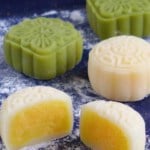
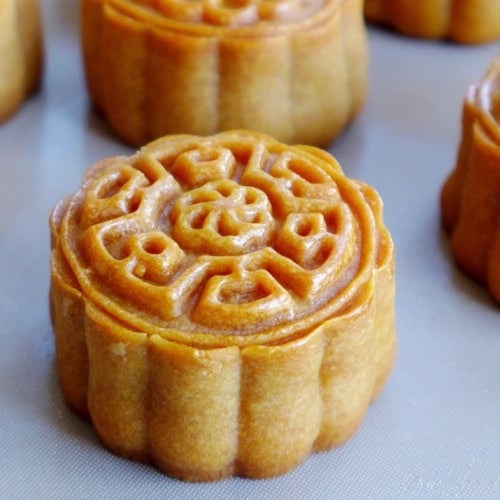
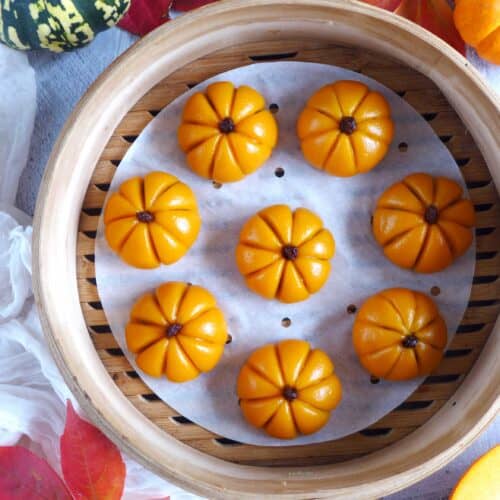
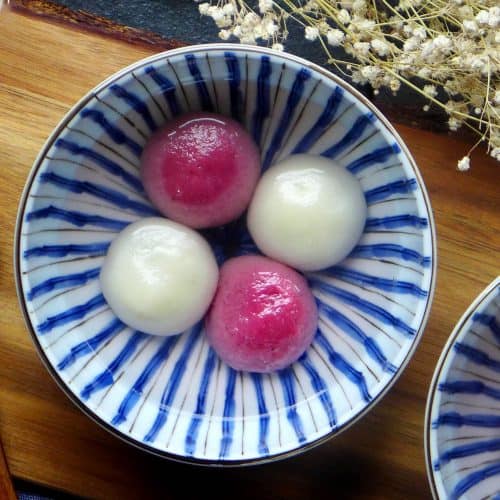
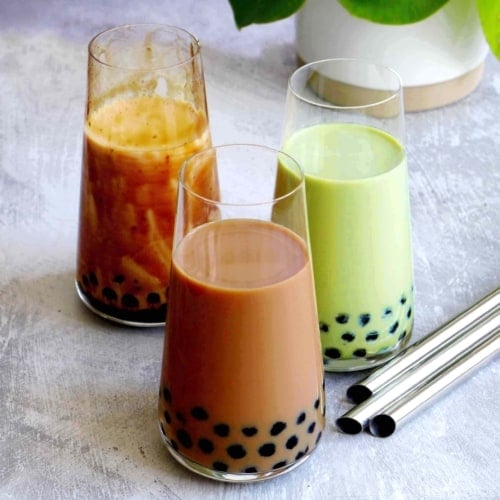
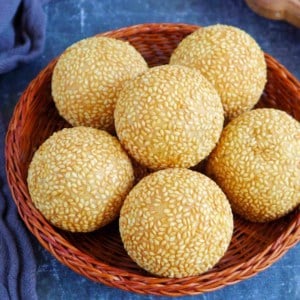
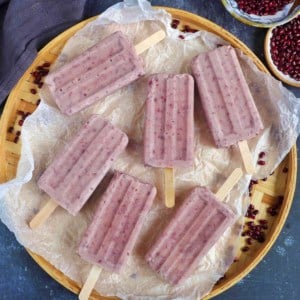
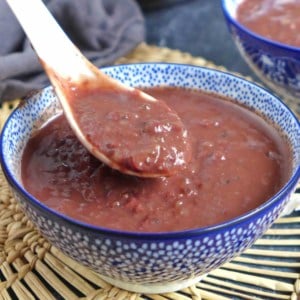
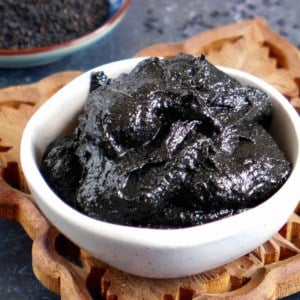
I’ve never tried freezing the dough. Although not 100% sure, I assume the freezing process would dry out the dough thus change its texture.
wow I made this recipe as is but used a 75g mold so i divided the recipe into 6 instead of 9, and i also wrapped a mini strawberry in each custard filling ball. WOW so good. thank u so so much for this recipe!! LOVE IT!! it just tastes like super fresh and delicious mochi with amazing filling.
With strawberries? That sounds so delicious! I’ll try it next time.
My first attempt has been successful. Also played with colours and the cakes came out pretty. Also the sugar level is just right, something everyone pointed out was good for them as the shop bought cakes are super sweet! Love this recipe, easy to follow as I’m not a great dessert maker! 😁
When it comes to Chinese sweet treats, one of the best compliments you could give is “They aren’t too sweet/不太甜!” Haha!Glad you’ve enjoyed!
I just finished making the Bingpi moon cakes with another recipe in Chinese. My daughter wants the recipe in English. Your food blog just comes in handy. Now I can direct her to your blog for the Chinese cooking.
Thank you for sharing your dishes and cooking knowledge.
My pleasure to share Carol! Happy Mid-Autumn Festival 中秋快乐!
Is it possible to use food colouring to colour the dough?
Yes, you can. If it’s powder colouring, following the instructions in the recipe. If it’s liquid colouring, add it to the mixture before steaming. Happy cooking!
Hello! I used your custard recipe for my baked mooncake. It is delicious! Is storage for room temp for 3 days or 2 weeks in the fridge okay for the custard?
Yes Julie. Keep them in airtight containers away from direct sunlight. Enjoy!
Hi there!
I’ve only made the Vietnamese of this snow skin cake (banh deo) which uses cooked glutinous rice flour (the flour itself has been cooked) and therefore, the process of making it is very different to your method, since you steam the dough. A common problem I run into when making banh deo is that the pattern that I imbed into the cake sort of… melts away? Like the details start to become undefinable (really annoying!). My question is if your method of dough does the same overnight?
I’ve heard of the cooked glutinous rice flour method but I haven’t tried it yet. Using my method, the pattern doesn’t disappear.
Hello there are amazing! How do you make tricolour snowskin mooncake like in your picture? I’d love to try that 🙂
Hi Lydya! I kneaded three pieces of leftover dough together.
Hello,
Love your recipes! If you don’t mind me asking, what is the diameter of your mooncake mold?
Hi Bailey! My mold measures about 5cm in diameter
I found your recipe and I can’t wait to try it. But id like to clarify something first. Condensed milk…. Do you mean sweetened condensed milk? Or evaporated milk?
Hi Julie! It’s condensed milk not evaporated milk. They’re very different therefore not interchangeable. Happy cooking!
Can I use MOCHINKO as the glutinous rice flour?
I’ve never tried making them with Mochiko but I assume it works as it’s made from short-grain glutinous rice.
Thank you!! Will try soon 🙂